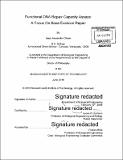Functional DNA repair capacity assays : a focus on base excision repair
Author(s)
Chaim, Isaac Alexander
DownloadFull printable version (37.93Mb)
Other Contributors
Massachusetts Institute of Technology. Department of Biological Engineering.
Advisor
Leona D. Samson.
Terms of use
Metadata
Show full item recordAbstract
The integrity of our DNA is challenged by roughly 100,000 lesions per cell on a daily basis. Failure to cope with DNA damage can lead to cancer, immunodeficiency and degenerative disease. Quantitating and understanding an individual's DNA repair capacity may enable us to predict and prevent disease in a personalized manner. Base Excision Repair (BER) is known for the recognition and repair of endogenous and exogenous mutagenic non-helix-distorting lesions produced by DNA base alkylation, deamination and oxidation. BER is initiated by the action of one of eleven DNA glycosylases known-to-date. Many studies have shown that levels of these glycosylases can vary between individuals, suggesting a basis for inter-individual differences in DNA repair capacity. Moreover, the methods for measuring DNA repair capacity used so far are cumbersome, time consuming, low throughput and only allow for the analysis of one glycosylase at a time. We have taken a fluorescence-based multiplex flow-cytometric host cell reactivation assay wherein the activity of several DNA glycosylases and their immediate downstream endonuclease (APE1) can be tested simultaneously, at single-cell resolution, under physiological conditions. Taking advantage of the transcriptional properties of several DNA lesions we have designed and engineered specific fluorescent reporter plasmids for OGG1, AAG, MUTYH, UNG and APE1. Inter-individual differences in DNA repair capacity of a panel of cell lines derived from healthy individuals have been measured. Regression models that incorporate these measurements have been developed in order to predict cellular sensitivity to the chemotherapeutic and DNA damaging agents 5-FU, H₂O₂ and MMS, with the interest of understanding the contributions that these differences can have on personalized disease prevention and treatment. Finally, we have conducted a pilot population study with 56 healthy subjects where we implemented all the methods developed in order to determine the feasibility of measuring DNA repair capacity variations in a healthy human population. Additionally, we report the discovery of a novel in vivo role of the TC-NER pathway in the repair of the lipid-peroxidation product, 3,N⁴-etheno-cytosine.
Description
Thesis: Ph. D., Massachusetts Institute of Technology, Department of Biological Engineering, 2016. Cataloged from PDF version of thesis. Includes bibliographical references.
Date issued
2016Department
Massachusetts Institute of Technology. Department of Biological EngineeringPublisher
Massachusetts Institute of Technology
Keywords
Biological Engineering.